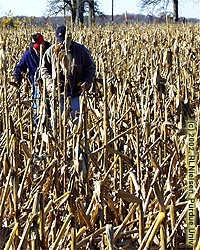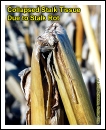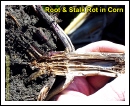

![]() he 2002 growing season has been anything but kind to the
Indiana corn crop. The delayed planting season put the crop behind the
proverbial 8-ball from day one. Various combinations
of stresses (including soil compaction, corn rootworm injury to roots,
initially wet soils, and eventually dry soils) subsequently affected crop
development throughout the summer months. Areas of the state are still in the
grip of unusually dry weather that is limiting the photosynthetic ability of
the corn plant “factory” during the important
grain filling period.
he 2002 growing season has been anything but kind to the
Indiana corn crop. The delayed planting season put the crop behind the
proverbial 8-ball from day one. Various combinations
of stresses (including soil compaction, corn rootworm injury to roots,
initially wet soils, and eventually dry soils) subsequently affected crop
development throughout the summer months. Areas of the state are still in the
grip of unusually dry weather that is limiting the photosynthetic ability of
the corn plant “factory” during the important
grain filling period.
 What triggers this fearmonger
alert is the fact that corn under such photosynthetic stress during grain fill
tends to cannabilize and remobilize a portion of its stalk carbohydrate
reserves to satisfy the physiological demands of the developing kernels. The
subsequently lower stalk carbohydrate concentrations, plus the fact that root
health may be suffering from the season-long stresses plus the current dry soil
conditions and the limited carbohydrates available for maintenance of root
tissue, increases the susceptibility of the crop to infection by various root
and stalk rot organisms.
What triggers this fearmonger
alert is the fact that corn under such photosynthetic stress during grain fill
tends to cannabilize and remobilize a portion of its stalk carbohydrate
reserves to satisfy the physiological demands of the developing kernels. The
subsequently lower stalk carbohydrate concentrations, plus the fact that root
health may be suffering from the season-long stresses plus the current dry soil
conditions and the limited carbohydrates available for maintenance of root
tissue, increases the susceptibility of the crop to infection by various root
and stalk rot organisms.
While I’ve not heard of any significant discoveries of stalk rot yet in this year’s crop, I nonetheless believe folks should spend some time walking fields during the next several weeks and inspecting the condition of the roots and lower stalks to confirm whether the problem is developing. Fields where root or stalk rots are discovered should be scheduled for early harvest relative to other fields with better stalk health in order to minimize the risk of significant mechanical harvest losses due to downed corn.
The inspection techniques are simple. Where plants appear to be healthy, dig up a few plants, shake or wash off the soil from the root ball, and inspect the roots for obvious discoloration or death from root rot diseases. Split the lower stalk and look for obvious discoloration or deterioration of the inner stalk tissue. Where the plant appearance itself suspiciously suggests diseased stalk tissue, squeeze the lower stalk. If it collapses easily, you’ve got trouble. If you cannot squeeze it easily, you’re probably okay for now.
 Stalk collapse from stalk rot |
 Root & stalk rot appearance in split stalk |
 For other
information about corn, take a look at the Corn Growers Guidebook on the World
Wide Web at http://www.kingcorn.org
For other
information about corn, take a look at the Corn Growers Guidebook on the World
Wide Web at http://www.kingcorn.org